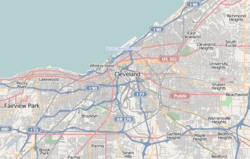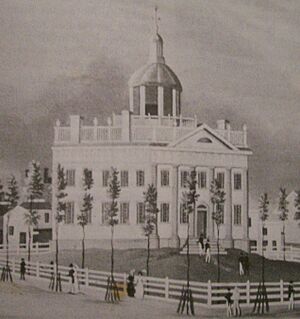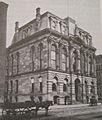Cuyahoga County Courthouse facts for kids
Quick facts for kids |
|
|
Cuyahoga County Courthouse
|
|
|
U.S. Historic district
Contributing property |
|

Cuyahoga County Courthouse in Downtown Cleveland
|
|
| Location | Cleveland, Ohio |
|---|---|
| Architect | Lehman & Schmitt |
| Architectural style | Beaux Arts |
| Part of | Cleveland Mall (ID75001360) |
| Added to NRHP | June 10, 1975 |
The Cuyahoga County Courthouse is a very important building in downtown Cleveland, Ohio. It sits at the north end of the Cleveland Mall. This building is where many legal and government activities for Cuyahoga County take place.
In 1975, the courthouse was added to the National Register of Historic Places. This means it's recognized as a special historical place. It's part of a larger plan for downtown Cleveland, which includes other important buildings like the Cleveland Public Library and Cleveland City Hall.
Contents
History of the Courthouse Buildings
Cuyahoga County was created in 1807. At first, there wasn't a permanent place for the county government. Cleveland was chosen as the temporary county seat. The courts met in different taverns and inns while waiting for a proper building.
First Courthouse (1813)
The first courthouse was finished in 1813. It was a simple stone building designed by Levi Johnson. It had a basic design with a few doors and windows. The roof was pointed, and it had chimneys on each end. This building was used when Cleveland officially became the permanent county seat.
Second Courthouse (1828)
By 1828, the county needed a new, bigger courthouse. Henry Noble built this new two-story brick building. The front had four large columns, which are called Doric columns. These columns supported a flat top section. The building also had a small tower, called a cupola, in the middle of the roof. This cupola had smaller columns and a weather vane on top. This courthouse was used until the 1850s.
Third Courthouse (1858)
As Cleveland grew, so did the need for more space for legal work. The county decided to build a new courthouse away from Public Square. This new building was finished in 1858. It was designed by J.J. Husband and built of stone in the Italianate style. This style often features decorative details and tall windows. The building had a central entrance and a fancy roof called a mansard roof with windows sticking out. This building was used until 1875.
Fourth Courthouse (1875)
In 1875, a fourth courthouse was built on Seneca Street (now West 3rd Street). It was almost square and housed various offices and courts. The county jail was located behind it.
Expansion of the Third Courthouse (1884)
Even with the new courthouse, more space was needed. Instead of building another new one, the county decided to add to the third courthouse on Public Square. In 1884, two more stories were added to it. This changed the building from two-and-a-half stories to five stories tall. The front of the building was also updated with more arched windows and a larger triangular top section, called a pediment.
The Current Courthouse (1906-1912)
Eventually, the county needed a much larger and more modern building. The design for the current courthouse was given to Walter Blythe. It was built between 1906 and 1912 by the architectural firm Lehman & Schmitt.
This courthouse was designed in the Beaux Arts style. This style was popular for grand public buildings, similar to those found in Washington, D.C. The building is part of the Cleveland Group Plan from 1903. This plan was a big idea to create a beautiful downtown area with important buildings. All the earlier courthouses were later taken down.
Exterior of the Current Courthouse
The courthouse is made of a pink granite stone from Massachusetts. The ground floor has a rough, textured look, which is called rusticated masonry. It has deeply set, arched windows and doors. Each arch has a stone wedge at the top called a keystone.
The main entrance has bronze statues of Thomas Jefferson and Alexander Hamilton. These were sculpted by Karl Bitter. Above the entrance, three large arched windows let light into the main courtroom. These windows are between tall, grooved columns.
Along the top of the building, there's a decorative band called a frieze. It has the words "Cuyahoga County Courthouse" carved into it. Above this, you can see stone statues of famous lawgivers from history. Two of these statues, of Edward I and John Hampden, were made by the famous sculptor Daniel Chester French.
The back of the building, which faces Lake Erie, looks similar to the front. It has the inscription "Obedience to Law is Liberty." A statue of Alfred the Great stands on the north side of the building.
Interior
Inside the courthouse, you can find beautiful murals. These large paintings were created by several artists, including Frank Brangwyn, Violet Oakley, Charles Yardley Turner, Max Bohm, and Frederick Wilson.
Images for kids
See also
 In Spanish: Palacio de Justicia del Condado de Cuyahoga para niños
In Spanish: Palacio de Justicia del Condado de Cuyahoga para niños







